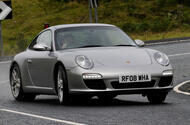The most tech-rich, driver-focused 911s of the period are now within most buyers’ reach – should you take the plunge?
The sixth-generation (or 997) Porsche 911 is every bit as outrageously competent and delicate to drive as you would imagine. Even the basic versions are just fabulous sports cars.And let’s not mess about: the basic version is the one to go for. When it was launched in 2004, the Carrera produced 321bhp, 272lb ft of torque and, when fitted with the six-speed manual gearbox, a 0-62mph time of 4.8sec – fast even by today’s standards.Of course, this being a 911, there was a variant for every taste and market. These included the 4, S, GTS, 4S, 4 GTS, GT3, GT3 RS, Turbo, Turbo S and GT2. A Sport Classic variant was introduced in 2012 on the facelifted ‘997.2’ car, which itself was introduced in 2009.There isn’t enough room here to dissect each and every one, but they can be summarised thus: if you want precision and poise, buy a 4, S or GTS. If track driving is your bag, buy a GT3 or GT2. If you enjoy crushing continents, buy a Turbo. And if you want the one that we recommend for its inherent balance and daintiness, buy the standard Carrera.No matter which 997 you go for, you will get a car that, for its time, came dripping with technology. This was the first Porsche to get the brand’s new PDK dual-clutch automatic – a welcome departure from the sluggish Tiptronic torque converter that preceded it.It was also the first Porsche to have direct injection, torque vectoring and variable-geometry turbochargers (on Turbo models, obviously) and the first to be offered in Sport Classic guise, which sold out in 48 hours.While it didn’t look that different from the 996 that it replaced, only the roof panel was carried over and a huge amount of work went into its aerodynamics. The swooping, bulging, 993-inspired bodywork reduced the drag coefficient from 0.30 to 0.28 for the Carrera, reducing lift and improving airflow.So the 997 was a trailblazer. But that wasn’t what defined it – the way it drove was. Take it on a winding road and your confidence in its ability will quickly turn to trust; your scepticism will turn to disbelief as its poise refutes the tail-heavy weight bias; and any driving talent you have will be nurtured by a grippy, flat-nosed determination to hurl you out of a corner. No wonder we awarded it five stars when we road tested it back in 2004.It’s fair to say, then, that this car came with a measure of drivability that bordered on the freakish – and that’s before you get to the engines. They ranged from the 3.6-litre flat six fitted to the standard Carrera to the sensational 4.0-litre unit in the GT3 RS. S versions and above got a 3.8-litre engine, with outputs ranging from 350bhp in the Carrera S to 522bhp in the Turbo S, itself a ruthlessly controlled tribute to forced induction.Those engines sent their power through a five-speed automatic, a six-speed manual or, in later examples, a seven-speed PDK.As a result of Porsche’s typical attention to drivability, the 997 is a hugely desirable car, prices for which are high and are likely to stay that way. But many are within reach, from Turbos with around 60,000 miles to Targas with less than half that. And as for Carreras? A good one of those will set you back around £23,000.







